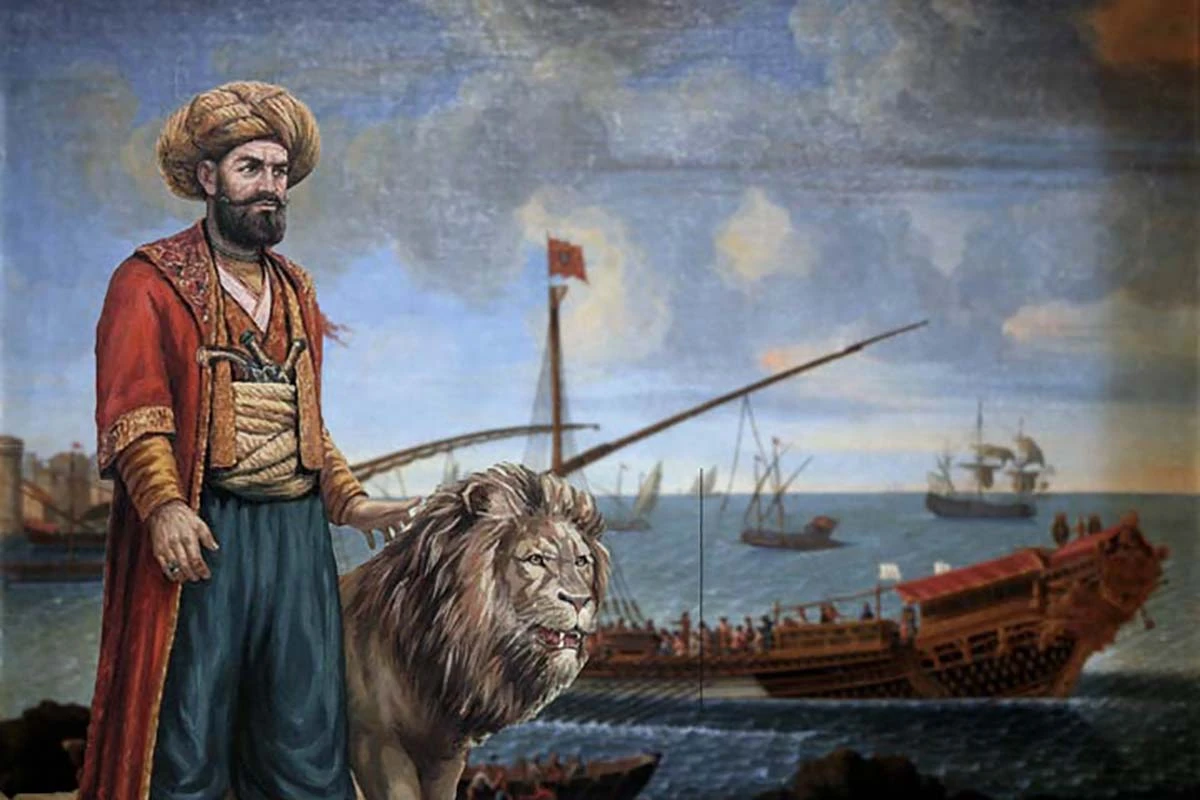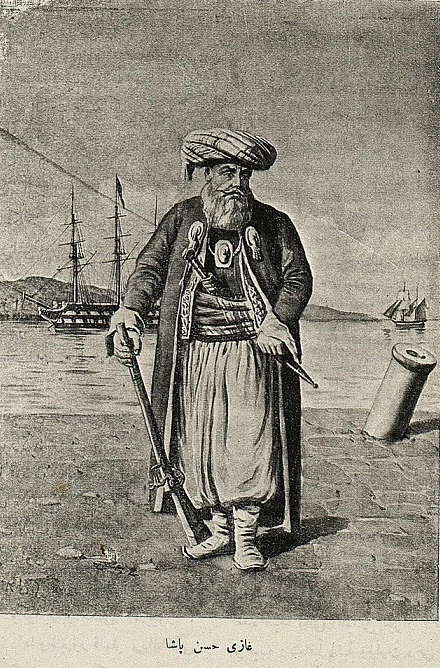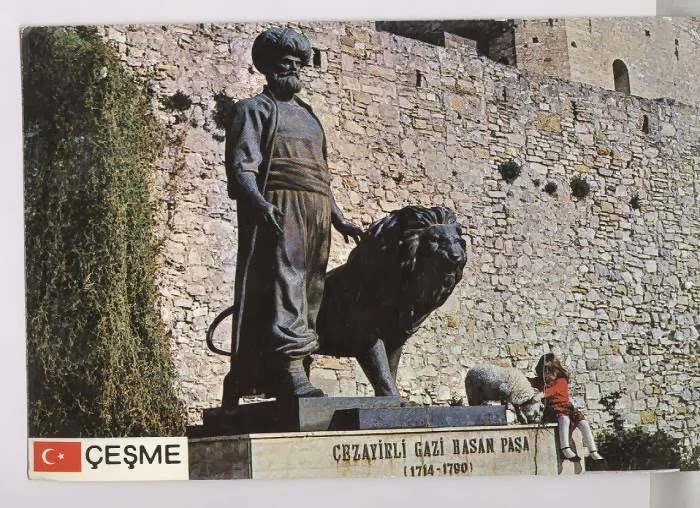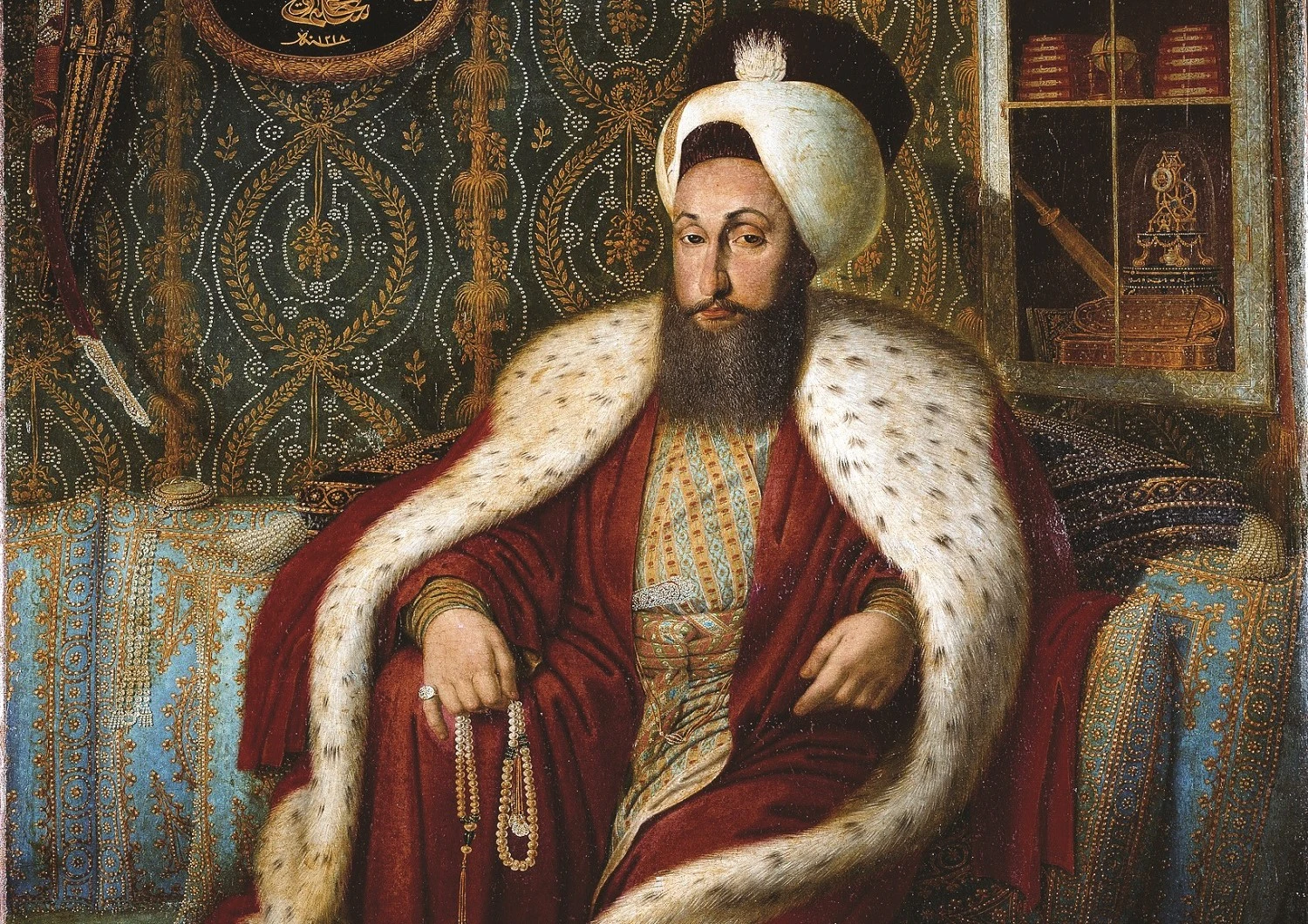Lionhearted Admiral: Gazi Hasan Pasha of Algiers
 Depiction of Ottoman Gazi Hasan Pasha of Algiers in Turkish textbook, accessed on April 21, 2025.
Depiction of Ottoman Gazi Hasan Pasha of Algiers in Turkish textbook, accessed on April 21, 2025.
One of the most valiant figures in Ottoman series, Gazi Hasan Pasha of Algiers was a character who achieved success in the tasks he undertook. The exact date of Hasan Pasha’s birth is unknown, but it is estimated that he was born between 1713 and 1715. While there is no definitive source regarding his nationality, it is suggested that he was from the Cacausus or Pomak or from tribes near the Iranian border. His destiny seemed to have a bad start when he was taken as a war captive at a young age and sold to Haci Osman, a merchant from Tekirdag, but this situation would later change unexpectedly.
In his youth, he also engaged in trade like his master and, following the customs of the time, turned to piracy. Intending to go to the renowned captains of Algiers, the ship he boarded was attacked by pirates en route. He drew his yataghan (a type of Turkish sword) and jumped onto the pirate ship. However, after a while, when the rammed (when one ship approaches another to touch) ships separated, he realized he was alone on the enemy vessel. Undeterred, he continued to fight, managing to kill some of the crew and lock the rest in the hold, thus claiming the ship as his first bounty. When he reached Algiers, his incredible adventure had already become known. He was taken into service by the Dey of Algiers, who gave him the ship and a coffeehouse. Having seized a ship almost single-handedly brought him both fame and the position of port governor in Algiers, followed by the governorship of the Sanjak of Tlemcen.
In 1738, he joined the Janissary Corps and proved his courage once again during the siege of Belgrade. It is said that he would openly express his thoughts to the Sultan, feared no one, and was unyielding. Sources also mention that he kept a lion by his side, which he had taken and raised as a cub during a hunt. There is no doubt that this lion he kept on his ship further enhanced his imposing presence. Some foreigners who knew him said that Hasan Pasha had the spirit of a lion but did not instill this spirit in his soldiers.
He married Emine Hanim, the daughter of his adoptive father Hacı Osman Aga, and had a daughter. While the Bey of Tlemcen, he learned that the Dey of Algiers was planning to assassinate him due to disagreements, so he went to Spain and Italy, and from there to Istanbul. Following the Dey of Algiers’ complaint that he had fled with money from the Tlemcen treasury, he was imprisoned and interrogated. When the accusation proved false, he was released. In 1760-1761, he began his service in the Ottoman navy as a ship commander.
In the navy, he successively rose through the ranks, becoming a Rear Admiral (riyale) in 1762, a Vice Admiral (“patrona”) in 1766, and a Grand Admiral (“kapudane”) a year later. His two terms as Captain-General (“kaptan-i derya”) represent the highest rank attainable in the Ottoman navy. Due to his imposing appearance and large mustache, he was initially nicknamed “Pala Bıyıklı” (Mustachioed Sword), but he later became known by the epithets “Cezayirli” (of Algiers) and “Gazi” (Veteran). He served as Captain-General between 1770-74 and then for a second time between 1774-1789.

His first appointment as Captain-General was followed by positions as the Guardian of the Çanakkale Strait, Serasker (commander-in-chief), Governor-General of Anatolia, and Serasker of Ismail and Ruscuk. During his long second term as Captain-General, fearing his power and influence, he was briefly appointed as the Governor of the Morea, but he returned to his previous post. By informing Sultan Abdul Hamid I of Halil Hamit Pasha’s attempt to dethrone him, he proved his loyalty and gained the trust of the capital. Some researchers suggest that this event was orchestrated by him to eliminate his rival Hamit Pasha, but this loyalty increased his dominance over the Sultan, and important tasks were entrusted to him.
During Hamit Pasha’s grand vizierate, Hasan Pasha, taking the Prussian army as an example in military preparations, applied for artillery and engineers to be sent from Germany. He also wanted to build warships and frigates at the port of Emden. However, when Prussia adopted a neutral stance, he could not realize his requests. The strained Ottoman-Russian relations materialized with the declaration of war in 1768.
In line with Russia’s long-standing ambition for a Mediterranean policy, a fleet of 24 ships under the command of Russian Admiral Alexi Orloff sailed from Gibraltar and entered the Aegean Sea. In the two-hour Battle of Koyun Islands on July 5, 1770, Cezayirli Hasan Bey faced Russian Admiral Spiridof. In the battle, both captains’ galleons were set ablaze. According to Fevzi Kurtoğlu’s account, Hasan Bey jumped into the sea from his burning galleon, Burc-u Zafer, wounded but with his sword in his mouth, and survived.
The approximately 30-ship Ottoman fleet, brought into Cesme harbor by a wrong decision of Captain-General Husamettin Pasha, was deprived of maneuverability in the crowded port. The small size of the harbor and the close proximity of the ships made the Russians’ task easier. Guided by an English admiral, Russian fireships silently approached in the darkness of the night of July 7th. Using oily rags and mortars, they first ignited one galleon, and the entire fleet burned one after another, like falling dominoes. Only the flagship (the ship of the fleet’s admirals) of Captain-General Husamettin Pasha managed to escape. Hasan Pasha, setting his own burning ship alongside a Russian vessel, sank both of them.
Around the time the Ottoman-Russian war began, the Ottoman navy consisted of 22 galleons. Eight of these were sent to the Black Sea, four remained in the shipyard due to damage, and ten sailed to the Mediterranean. While nine of these ten galleons were burned in Cesme harbor, one that managed to leave the harbor fell into Russian hands. Thus, the navy was left with 12 galleons. According to some sources, the Russian fleet consisted of 18 ships, while the Ottoman fleet comprised 16 galleons, 6 frigates, and other support vessels.
Although Captain-General Husamettin Pasha escaped with his ship to Chios, he later paid for this imprudence with his execution. With the destruction of the navy, Ottoman naval dominance at that time came to an end. During this period, Hasan Bey was promoted to the rank of two-tailed pasha. In July 1770, the fortress of Limnos was besieged by the Russians. In October, to save the fortress, which was on the verge of falling, he set out with a small force barely gathered from the rabble of Istanbul, without sufficient ammunition and even without cannons.
This situation was described as madness by the French advisor Baron de Tott, who advised the state officials not to engage in such reckless actions again. However, the Grand Vizier retorted to Baron de Tott, “I also know that Hasan Pasha’s action is a folly contrary to the rules of war, but if the Pasha succeeds, excellent; if not, Istanbul will be rid of 4,000 vagabonds.” When Hasan Pasha’s small force entered the harbor before dawn, the fortress was about to surrender out of desperation. After a zealous assault, the Russians were forced to lift the siege.
Due to his fearless courage in saving the Canakkale Strait from threat, he was bestowed with the title of “Gazi” (Victorious). He was also awarded a golden wreath and became the Captain-General and Guardian of the Straits. With the death of Sultan Mustafa III and the ascension of Sultan Abdul Hamid I to the throne in 1774, he was dismissed from the position of Captain-General on February 27, 1774, and appointed as the Governor of Anatolia. However, this decision was reversed a few months later, and he was reinstated to the position he would hold for 15 years.
A state that only considered the Mediterranean as its sphere of influence realized, after the Treaty of Kucuk Kaynarca in 1774, one of the heaviest agreements in history that would lead to its fragmentation, that its forces needed to be doubled upon hearing about the Russian shipyards in the Black Sea. However, no significant progress could be made in the development of its navy until the time of Kucuk Huseyin Pasha. The granting of autonomy to Crimea and the Russian patronage of the Orthodox in the Ottoman Empire with the Treaty of Kucuk Kaynarca were serious losses.
Hasan Pasha, considered the most warlike man of his time and not well-liked by the French, was initially against going to war with the Russians. According to him, it was necessary to work towards establishing a superior navy in the Black Sea and the Mediterranean, and he himself was working towards this goal. Grand Vizier Darendeli Mehmet Pasha, to keep Cezayirli out of sight, began to use the navy for land operations, assigning him the task of eliminating a brigand in the vicinity of Izmir and Aydin. After the campaign season of 1775, Zahir Omer, who had rebelled in the regions of Mehmet Aga and Akka, was captured, and their heads were sent to Istanbul.
Following this, between 1776 and 1779, he defeated Sheikh Tahir, who had rebelled on the Syrian coast, captured the Akka fortress, and brought the Morean rebels under control. The Russian navy had anchored off the coasts of Syria and Egypt and had begun to cooperate with those who opposed Ottoman rule. The task of restoring order in Egypt, where the Mamluk beys were in conflict, was given to Hasan Pasha instead of Cezzar Ahmet Pasha, and his arrival in Alexandria in June 1786 caused widespread terror. The Pasha sent out proclamations stating that the injustices against the people and the tax obligations would be abolished, that Sultan Suleiman’s law would be implemented, and that everyone would be governed justly and equitably.
He also stated that he had been appointed by the Sultan due to the cruelties of Ibrahim and Murat Bey. He clashed with those who opposed this situation, and on his return journey, the money he collected from there would be very useful during the Russian and Austrian wars, when the state was experiencing a financial crisis.

Gazi Hasan Pasha’s attempts to save Crimea
The reason for his return without securing the Egyptian issue was the declaration of war on Russia on August 17, 1787. The Ottomans, who could not find allies and were dismayed when the Austrians also sided with Russia, found themselves in a hopeless shock. In the rivalry between the pro-war Grand Vizier Koca Yusuf Pasha, who marked the era, and the experienced Gazi Hasan Pasha, the pro-war side prevailed. The navy was to set sail for the Black Sea with the aim of retaking Crimea from the Russians. Before the departure, Hasan Pasha gathered all the ship officers and made them swear an oath.
As the treasury was depleted, money was needed. It was known that Hasan Pasha had earned a large sum from trade and piracy. The Sultan requested 12,000 purses of akçe (Ottoman currency) for the treasury, and Hasan Pasha completed this amount in gold overnight and sent it to the palace. In December 1788, the light fleet (a fleet consisting of light, small ships suitable for navigating shallow waters) under the command of Hasan Pasha anchored off the fortress of Ozi, an important border point for the Russians. Heavy casualties were suffered in the repeated mutual assaults with the Russians, and a large part of the light fleet was lost.
The reinforcements expected from land and sea failed to arrive. The buoys they had placed at suitable points for the ships to pass were moved by the Russians in the middle of the night, and each ship went in the wrong direction and ran aground in the shallows. As a result of the bloody clash, the maneuvering light fleet was largely destroyed. Upon the wrath of Sultan Abdul Hamid, who summoned him to Istanbul, the Pasha boldly told the Sultan, “Was our agreement not that the imperial army would advance from land and the imperial navy from sea against the enemy? Since the army went against Austria, the Russians, with all their might, attacked Ozi and were victorious. My Sultan, your servant is but one man; even if I were Plato, it is impossible to resist with so few soldiers.” However, even though this outburst was justified, it could not prevent the Sultan from becoming alienated from him and his dismissal from the position of Captain-General during the reign of Sultan Selim III.

Selim III appoints him as Grand Vizier despite his dislike
Sultan Abdul Hamid had passed away due to the news of Ozi falling to the Russians and the subsequent massacres. Hasan Pasha would later be appointed as Serasker (commander-in-chief) by Sultan Selim III to retake Ozi. The Russian fleet sailed into the Black Sea and anchored at Snake Island off the Kiliya (Chilia) branch at the mouth of the Danube. Hasan Pasha reached this location on August 12, 1788. His other ships had fallen behind, but he managed to inflict many casualties with battery fire. He rammed and captured a Russian galleon.
The Russians began to flee before his other ships could catch up. He pursued their ships as far as Sevastopol but could not capture them. The captured Russian ship was named the Hüdavendigar galleon. The importance of the Ismail fortress had been understood in the 1768 war, so after peace was made with the Russians, a very strong fortress was built there, and all its needs in terms of weapons and ammunition were met. Hasan Pasha laid siege to this strategically important fortress in 1789, the year Sultan Selim III ascended the throne, and on April 20, 1789, he was dismissed from the position of Captain-General and appointed as Serasker of Bessarabia.
He defeated and repelled the Russian soldiers at the Battle of Tabak Dere. When Akkerman, Belgrade, Bender, and Bucharest fell, Sultan Selim III was forced to appoint Gazi Hasan Pasha as Grand Vizier on December 3, 1789, despite his great dislike for him, to replace Cenaze Hasan Pasha. Although the Sultan granted him broad powers, his reluctance to allow these powers to be used shows that he could neither be with him nor without him. The burning of the fleet at Çeşme also marked the end of an era in naval history.
It became clear that the classical understanding of the navy was no longer sufficient and that a technological and scientific approach needed to be adopted. As defeats increased, the Ottomans, realizing that European soldiers were well-trained and that they themselves were lagging behind, followed the military modernization recommendations of foreign experts. When Hasan Pasha took command of the Ottoman navy in 1770, his first task was to rebuild the destroyed fleet. One of his most important achievements, despite being illiterate, was laying the foundations of the Mekteb-i Bahriye-i Sahane (Imperial Naval Academy), which is known today as the Naval Academy.
The school, established in a room in the Tersane-i Amire (Imperial Shipyard) district called Hendesahane (House of Geometry), was called Mühendishane (House of Engineering) from 1781 onwards. The establishment dates for the Muhendishane-i Bahri (Imperial School of Naval Engineering) are given as 1773 and 1776. The present-day extensions of the school are the Naval Academy and Istanbul Technical University. He spent the last days of his life with the Ottoman-Russian peace negotiations. The death of this zealous and determined vizier on March 30, 1792, pleased those who feared his severity but was a complete misfortune for the future of the army.
He completed his life as an intelligent, outspoken, reckless, extraordinarily brave, and strong-willed character, having achieved numerous successes. One day, while traveling incognito around Shumen (today in Bulgaria), he caught a cold, fell ill, and died. He was buried in the Bektashi lodge he had built in Shumen. In 1966, the Turkish Naval Attache in Sofia conducted research on his grave. It was learned that his tomb had collapsed due to neglect in 1963 and that a military artillery school had been built on top of it by the Bulgarians. Upon his death, he did not leave behind as much wealth and money as was thought. He had approximately 4,000 purses of akce and an estate with an annual income exceeding 1,000 purses, a mansion belonging to his wife in Kasimpasa, and a waterside residence between Uskudar and Kuzguncuk. He also had lodges, mosques, baths, and numerous fountains built in various places.



